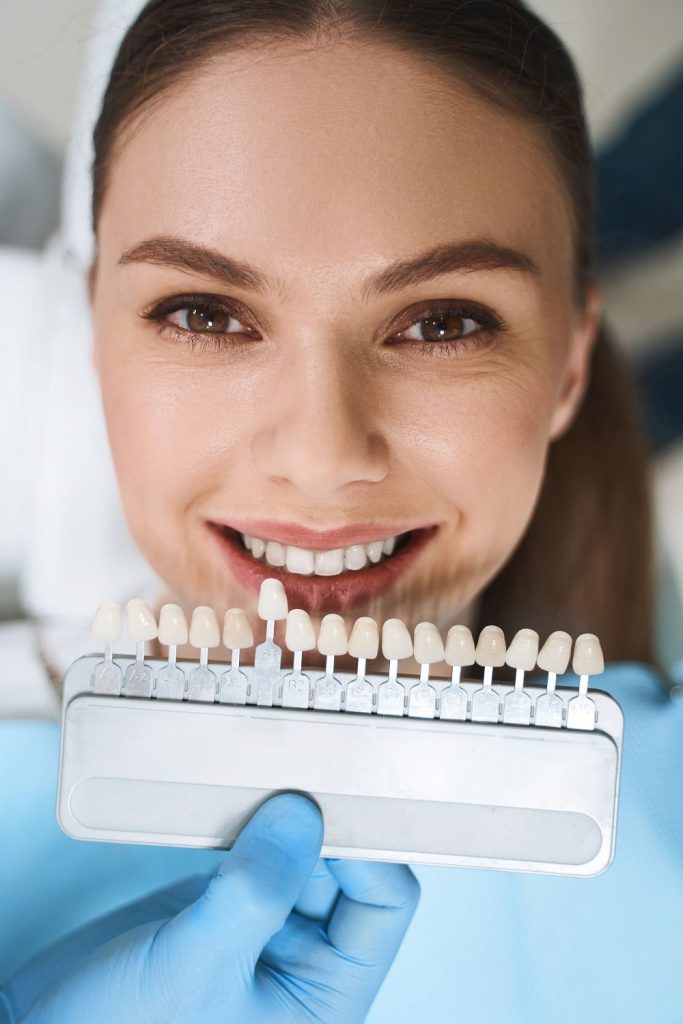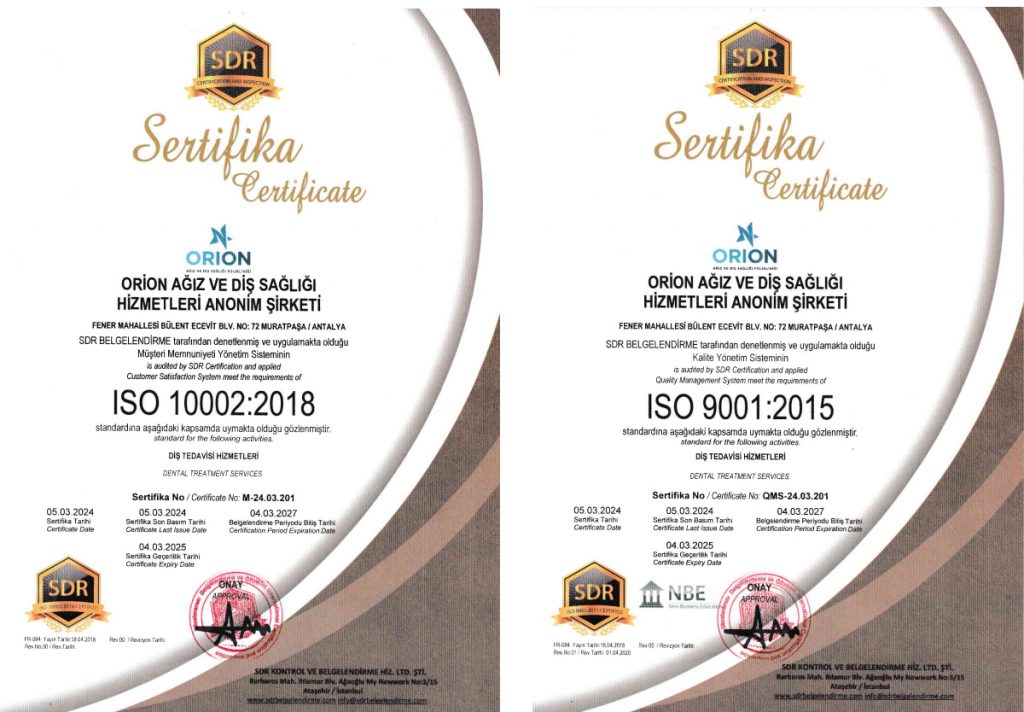- Fener Mah. Bulent Ecevit Blv. No:72 Muratpasa/ANTALYA

The healthy form, symmetry, and color of the gums are extremely important to design a healthy and beautiful smile. Smile Design is the name given to a number of dental treatments made to make you smile healthier and happier. In smile design; In smile design;
Most Used Methods in Dental Aesthetics;
Aesthetics has become increasingly important in today’s dentistry. Porcelain laminate veneers have started to be preferred frequently in front group teeth with the development of adhesive technologies and the maximum preservation of dental tissues. Lamina prostheses, meaning “leaf” in Latin, are like very thin porcelain leaflets that are affixed to the front of the tooth with special adhesives. As an alternative to full crowns in tooth discoloration that cannot be obtained with bleaching, hereditary structural disorders, closure of the gaps between teeth (diastema), midline disorders, mild crowding in patients who do not want orthodontic treatment, broken, worn teeth, bad condition, unhealthy, old restorations, they are made. Porcelain laminate veneers, which can be applied to almost every patient group, cannot be applied to patients with parafunctional habits (nail biting, pencil biting, teeth grinding). Porcelain laminate veneers are increasingly preferred due to their advantages such as removing very little material from the teeth (0.3-0.5 mm) or without removing them at all, their durability and their constant color.
These are prostheses that are applied as a crown prosthesis for the correction of dental defects in the anterior region for aesthetic purposes, in the construction of bridges in tooth losses, in teeth that have lost a large amount of material due to caries, fractures, abrasions, and which do not use metal in their infrastructure. Although metal-supported ceramic restorations have been used successfully for years, they have many disadvantages. Full ceramic restorations without metal support have been developed due to negativities such as the possibility of metal allergy, color changes in ceramics due to metal content, removal of more material from teeth for metal and ceramics, lack of light transmittance of metal and natural appearance. They are compatible with the teeth and surrounding tissues, imitate the tooth structure and color very well, they do not create dark discolorations in the gums caused by metal. Full ceramic crowns are the most natural types of veneers similar to our own teeth due to their light transmittance.
In teeth that have lost a large amount of material due to decay, fracture, etc., in cases where the upper structure of the tooth is weakened due to root canal treatment, in restoration of damaged teeth that cannot be treated with filling, they are applied without removing as much material from the teeth in the crown prosthesis (coating), and with maximum protection of the healthy tissues. In the first session, the decayed parts of the tooth are cleaned, the appropriate cavity is shaped and a measurement is taken and sent to the laboratory. The porcelain filling prepared specially for the patient’s tooth is adhered to the tooth with special adhesives in the next session. Thanks to these porcelain fillings with a hardness close to the tooth, the health of the tooth and surrounding tissues is preserved. They are resistant to chewing forces, aesthetic and long-lasting.
Problems Subject to Aesthetic Dentistry
Dentists today have many treatment options that were not available before to restore anterior teeth. A good diagnosis is imperative when the patient comes with a desire for aesthetic correction. Determining aesthetic problems objectively is essential for success.
It is the correction of natural teeth with small abrasions. Correction of cutting edges, rounding of sharp corners, correction of small fractures and ruptures.
It is a kind of composite application made by removing minimum material from the tooth or without removing it in the closing of small gaps, correction of crooked or rotated teeth, wear and light discoloration. Special composite materials are used for this purpose. It is preferred because it is extremely conservative, can be completed in a single session, can be applied with minimum abrasion on the tooth and gives aesthetically satisfactory results. However, since coloration may occur in the long term, it may be necessary to change after a certain period of time depending on the nutrition and brushing habits of the patient.
Moderate discoloration, closing of the gaps in the teeth, correction of crowded or twisted teeth is a porcelain application made by removing a medium degree of material from the tooth in cases of wear. Only the front surfaces of the teeth are abraded and prepared in the laboratory after the impression and applied to the teeth in the second session. Its most important advantage is its aesthetics and durability longer than direct composite applications.
Smile design includes the actions taken by the dentist in order to provide the smile image that is suitable for you in line with the directives. While determining the smile design; The facial features of the person, gender, age, smile symmetry, the alignment of the teeth, the colors, the appearance of the lips and the appearance of the gums are evaluated.
Zirconium crowns, which are common in aesthetic dental treatments, are also very important. Zirconium crowns are metal alloy with white color. The reason why it is especially preferred in aesthetic applications is that it is close to natural teeth and eliminates aesthetic concerns in deep cracks and deteriorated teeth. Zirconium tooth does not create a bad appearance, even if the gums are pulled over the years, because the material under it is the same color as the tooth.
We can list some of the advantages of zirconium-supported porcelain coatings as follows. It fits perfectly on the tooth as it is made untouched by computer-aided CAD CAM systems, and it is much more aesthetic than metal-supported porcelain because it reflects the light very well. Zirconium coating does not usually cause gum problems (gingival recession) due to its compatibility with gums and teeth. Although the cost seems to be a little too much for the beginning due to the zirconium crown, you can get much more efficient results when long-term use, tissue compatibility, durability and aesthetic appearance are taken into account.
The desire to shape the gums is one of the important steps of aesthetic dentistry.
If your gums attract more attention than your teeth and you have problems such as inflammation in your gums, these problems should be eliminated before moving on to other stages of smile design.
Especially gingivectomy or gingivoplasty methods are used for gum aesthetics. Gingivectomy is briefly the name given to the process of removing some of the gums by cutting. With this method, if your gums appear too much, reduction is provided. Or, necessary procedures are performed to remove the gums that have grown too large due to drug treatment.
Gingivoplasty is the name given to the shaping of healthy gums in and around the tooth. This procedure can usually be performed alone, but in some cases, it must be performed together with gingivectomy.
Bonding applications are the process of repairing the tooth with composite resin material to correct the decayed, broken and damaged structural condition.
Its color is white, and it is often used in aesthetic applications. Bonding applications are an easy process that is not very costly, so it is generally preferred to close the gaps between teeth.
Although the procedure time varies between half an hour and 1 hour, the number of sessions can be more than one with the number of teeth to be applied.
Aesthetic dental treatment consists of multiple parts that require many aesthetic situations to be evaluated together. Some of these are smile design, aesthetic arrangements in the gums (gingivectomy or gingivoplasty), bonding applications and zirconium supported porcelain veneers.

Copyright © 2022 Orion. Tüm Hakları Saklıdır.